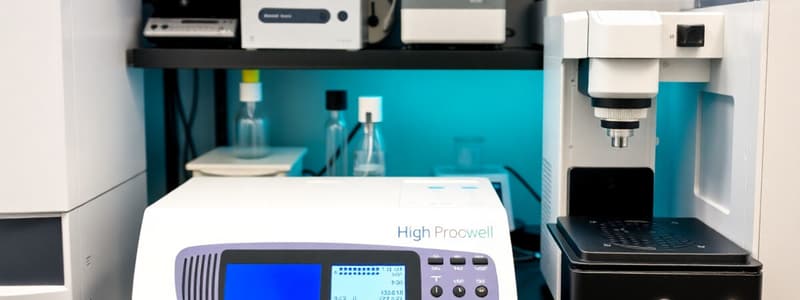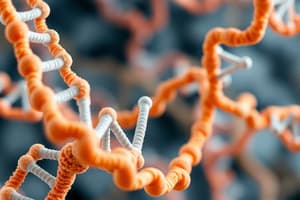Podcast
Questions and Answers
What is the primary purpose of a microcentrifuge in molecular biology?
What is the primary purpose of a microcentrifuge in molecular biology?
- To amplify DNA sequences using PCR.
- To analyze the concentration of proteins.
- To store samples at ultra-low temperatures.
- To separate cellular components from nucleic acids. (correct)
Which safety protocol is crucial when using a microcentrifuge?
Which safety protocol is crucial when using a microcentrifuge?
- Ensure tubes are balanced and placed symmetrically. (correct)
- Slightly tilt the microcentrifuge during operation.
- Maintain the microcentrifuge at room temperature.
- Stop the rotor manually to prevent damage.
What is the ideal temperature range for storing nucleic acids in an ultra-low temperature freezer?
What is the ideal temperature range for storing nucleic acids in an ultra-low temperature freezer?
- -40 to -80 degrees Celsius. (correct)
- -80 to -120 degrees Celsius.
- -20 to -40 degrees Celsius.
- 0 to -4 degrees Celsius.
What is a common application of gel electrophoresis in molecular biology?
What is a common application of gel electrophoresis in molecular biology?
Which instrument is specifically designed for measuring the concentration of nucleic acids?
Which instrument is specifically designed for measuring the concentration of nucleic acids?
What is the primary purpose of using extreme cold in ultra-low temperature freezers?
What is the primary purpose of using extreme cold in ultra-low temperature freezers?
Which of the following statements about proper handling of frozen samples is NOT accurate?
Which of the following statements about proper handling of frozen samples is NOT accurate?
How often should the condenser filter of an ultra-low temperature freezer be cleaned?
How often should the condenser filter of an ultra-low temperature freezer be cleaned?
What should be done if the ice build-up in the freezer exceeds 3/8 inches?
What should be done if the ice build-up in the freezer exceeds 3/8 inches?
To ensure the proper operation of the ultra-low temperature freezer, how often should the battery connections be checked?
To ensure the proper operation of the ultra-low temperature freezer, how often should the battery connections be checked?
Flashcards
What is a microcentrifuge used for?
What is a microcentrifuge used for?
A lab instrument used to separate cellular components from nucleic acids, typically handling 0.2 to 2 mL volumes and reaching speeds of 15,000-20,000 RPM.
What is the purpose of an ultra-low temperature freezer?
What is the purpose of an ultra-low temperature freezer?
This type of freezer maintains a temperature range of -40 to -80 degrees Celsius, preserving the integrity of DNA, RNA, and other nucleic acids over long periods.
What is the principle behind centrifugation?
What is the principle behind centrifugation?
This instrument utilizes a high-speed rotation to spin samples, separating components based on their density. This is commonly used in molecular biology to separate nucleic acids or proteins.
How does gel electrophoresis work?
How does gel electrophoresis work?
Signup and view all the flashcards
Explain the process of PCR (Polymerase Chain Reaction).
Explain the process of PCR (Polymerase Chain Reaction).
Signup and view all the flashcards
Why are ultra-low temperature freezers essential?
Why are ultra-low temperature freezers essential?
Signup and view all the flashcards
What is a key practice to avoid when using an ultra-low temperature freezer?
What is a key practice to avoid when using an ultra-low temperature freezer?
Signup and view all the flashcards
Why is checking the freezer door gasket important?
Why is checking the freezer door gasket important?
Signup and view all the flashcards
What is the importance of maintaining the battery within an ultra-low temperature freezer?
What is the importance of maintaining the battery within an ultra-low temperature freezer?
Signup and view all the flashcards
Why do you need to defrost an ultra-low temperature freezer periodically?
Why do you need to defrost an ultra-low temperature freezer periodically?
Signup and view all the flashcards
Study Notes
Instrumentation - Prelim Week 2
-
Learning Objectives: Students will be able to identify and describe the function of key molecular biology instruments, explain their application in nucleic acid and protein analysis, and understand associated safety protocols. Instruments included in the lesson are PCR machines, electrophoresis, spectrophotometers, centrifuges, and more.
-
Common Instruments in Molecular Biology: Images and descriptions of common equipment are presented, including microcentrifuge, ultra-low temperature freezer, gel electrophoresis machine, qPCr, vortex mixer, clean bench, and spectrophotometer.
-
Microcentrifuge: Used to separate cellular components from nucleic acids. Handles small volumes (0.2-2 mL). Achieves high rotational speeds (15,000-20,000 RPM). Important safety reminders include balancing tubes for even weight distribution and not exceeding maximum speed, avoiding stopping the rotor by hand.
-
Ultra-Low Temperature Freezer: Used to store DNA, RNA, and other nucleic acids at -40 to -80°C for long periods to maintain sample integrity. Extreme cold prevents contamination and microbial growth, ensuring purity of stored samples. Some utilize liquid nitrogen (LN2). Safety reminders include proper labeling of samples, not touching frozen items with bare hands, keeping the door closed/avoiding prolonged openings, and maintaining proper ventilation. There is also a maintenance schedule provided for defrosting, gasket/filter, condenser, and battery checks/maintenance.
-
Gel Electrophoresis: Used to isolate DNA/RNA fragments according to their size and assess quality/integrity of nucleic acid/protein samples. Smaller fragments migrate faster than larger fragments. Images showing electrophoresis gel results and a DNA ladder separation are presented. Related safety notes regarding chemical handling, proper equipment setup, waste disposal, and avoiding contamination were highlighted. Specifically, ethidium bromide, agarose gel, or other relevant chemicals should be handled with care.
-
qPCR (Real-Time PCR): Real-time PCR is used to measure and quantify specific nucleic acid amounts in a sample, with applications in gene expression analysis, pathogen detection/diagnosis, PCR cloning, and mutation detection.
-
Vortex Mixer: Used for rapidly mixing small liquid samples, creating a vortex or swirling motion to ensure sample homogeneity. Adjustable speed is key to accommodate different solution viscosities. Safety considerations include ensuring the motor is operating smoothly, avoiding overload, securing the equipment, placing it on a stable surface, and avoiding forceful pressure while in operation.
-
Clean Bench/Laminar Flow Hood: A sterile workspace to conduct experiments safely and prevent contamination (aseptic environment). Uses HEPA filters for contaminant removal. Maintenance involves maintaining a positive airflow pressure. Also highlighted as either a vertical or horizontal laminar-flow cabinet.
-
Spectrophotometer: Instruments used in measuring concentration (and purity) of nucleic acids/proteins. Small sample volumes as low as 1-2 µL can be measured. Measurements are based on absorbance values using the Beer-Lambert Law. Purity can be assessed from (260/280nm) ratios. Practical application notes like avoiding direct contact with the pedestal, proper pipetting, lint-free cleaning materials, and following the specific guidelines are vital.
-
PCR: Used to amplify specific DNA sequences (replicating many copies of a DNA segment) with applications in diagnostics, forensic analysis, and environmental monitoring. Safety notes regarding correct loading procedures and avoiding overload are highlighted. Proper temperature considerations during amplification and sample handling (e.g., proper pipette technique) are important considerations.
-
Biosafety Cabinet Class II: Safe handling of biological materials by creating a controlled environment that protects the user, the environment, and the sample from contamination by hazardous biological materials. Use of HEPA filters and proper classification of type (A1, A2, B1, B2) is crucial. Features like recirculating systems, proper air-flow guidelines, and preventative measures like dedicated ducts and HEPA filters are vital to the functioning of a Biosafety Cabinet.
Studying That Suits You
Use AI to generate personalized quizzes and flashcards to suit your learning preferences.




